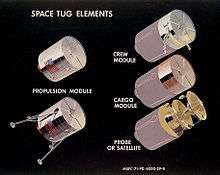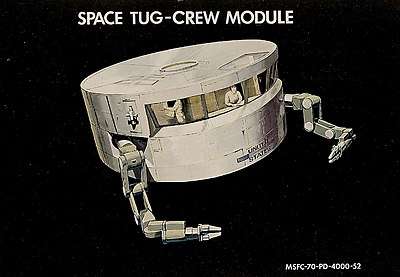Space tug
A space tug is a type of spacecraft used to transfer spaceborne cargo from one orbit to another orbit with different energy characteristics. An example would be moving a spacecraft from a low Earth orbit (LEO) to a higher-energy orbit like a geostationary transfer orbit, a lunar transfer, or an escape trajectory.

The term is often used to refer to reusable, space-based vehicles. Some previously proposed or built space tugs include the NASA 1970s STS proposal[1] or the proposed Russian Parom, and has sometimes been used to refer to expendable upper stages,[1] such as Fregat,[2] or Spaceflight Industries Sherpa.
Background
The space tug was first envisioned in the post-World War II era as a support vehicle for a permanent, Earth-orbiting space station. It was used by science fiction writer Murray Leinster as the title of a novel published in 1953 as the sequel to Space Platform, another novel about such a space station. [3]
NASA Space Transportation System

A reusable space tug was studied by NASA in the late 60s and early 70s as part of a reusable Space Transportation System (STS). This consisted of a basic propulsion module, to which a crew module or other payload could be attached. Optional landing legs could be added to land payloads on the surface of the Moon.[1] This, along with all other elements of STS except the Space Shuttle, was never funded after cutbacks to NASA's budget during the 1970s in the wake of the Apollo program.[4]
Space Shuttle era
Expendable upper stages
The Shuttle program filled the role of high-energy orbital transfer by the development of a solid-fueled single-stage Payload Assist Module and two-stage Inertial Upper Stage.
A more powerful liquid hydrogen fueled Centaur-G stage was developed for use on the Shuttle, but was cancelled as too dangerous after the Challenger disaster.[5]
Orbital Maneuvering Vehicle
NASA studied another space tug design, termed the Orbital Maneuvering Vehicle (OMV), along with its plans for Space Station Freedom. The OMV's role would have been a reusable space vehicle that would retrieve satellites, such as Hubble, and bring them to Freedom for repair or retrieval, or to service uncrewed orbital platforms.[6][7] In 1984, the Orbital Maneuvering Vehicle (OMV) preliminary design studies were initiated through a competitive award process with systems studies conducted by TRW, Martin Marietta Aerospace, and LTV Corporation.[8]
Twenty-first century proposals
Parom
The Russian RKK Energia corporation proposed a space tug named Parom in 2005[9] which could be used to ferry both the proposed Kliper crew vehicle or uncrewed cargo and fuel resupply modules to ISS.[10] Keeping the tug in space would have allowed for a less massive Kliper, enabling launch on a smaller booster than the original Kliper design.
SHERPA
Spaceflight Inc. developed SHERPA, which builds upon the capabilities of the Spaceflight Secondary Payload System (SSPS) by incorporating propulsion and power generation subsystems, which creates a propulsive tug dedicated to maneuvering to an optimal orbit to place secondary and hosted payloads. The maiden flight of two separate unpropelled variants of the dispenser was in December 2018 on a Falcon 9 rocket. This flight deployed 64 small satellites from 17 countries.[11][12]
VASIMR
The VASIMR electric plasma rocket could be used to power a high-efficiency space tug, using only 9 tons of Argon propellant to make a round trip to the Moon, delivering 34 tons of cargo from Low Earth Orbit to low lunar orbit. As of 2014, Ad Astra Rocket Company had put forward a concept proposal to utilize the technology to make a space tug.[13]
ISRO PAM-G
Indian Space Research Organisation has built an upper stage called PAM-G (Payload Assist Module for GSLV) capable of pushing payloads directly to MEO or GEO orbits from low Earth orbits.[14][15] PAM-G is powered by hypergolic liquid motor with restart capability, derived from PSLV's fourth stage. As of 2013, ISRO has realized the structure, control systems, and motors of PAM-G and has conducted hot tests.[16][17][18] PAM-G would form the fourth stage of GSLV Mk2C launch vehicle,[19] sitting on top of GSLV's cryogenic third stage.
Jupiter
Lockheed Martin made a concept proposal to NASA in 2015 for a design called the Jupiter space tug, to be based on the designs of two earlier Lockheed Martin spacecraft—Mars Atmosphere and Volatile Evolution Mission and the Juno—as well as a robotic arm from MDA derived from technology used on Canadarm, the robotic arm technology previously used on the Space Shuttle. In addition to the Jupiter space tug itself, the Lockheed concept included the use of a new 4.4 m (14 ft)-diameter cargo transport module called Exoliner for carrying cargo to the ISS. Exoliner is based on the earlier (2000s) ESA-developed Automated Transfer Vehicle, and was to be jointly developed with Thales Alenia Space.[20][21][22] In the event, NASA did not agree to fund the Jupiter development, and Lockheed Martin is not developing the tug with private capital.
Mission Extension Vehicle
In 2011 ViviSat a joint project between U.S. Space and ATK proposed the Mission Extension Vehicle. In 2016 ViviSat was dissolved when U.S. Space declared bankruptcy and ATK merged with Orbital Science Corporation to form Orbital ATK. In 2017 Orbital ATK got the go ahead from the FCC to begin development of the spacecraft with new partner Northrup Grumman who was developing a tug of their own. In 2018 both companies sat aside and polled their resources and in June of that year they merged and the two projects became one and the new company was called Northrop Grumman Innovation Systems. On 9 October 2019 the first of these tugs MEV-1 was launched from Baikonur Cosmodrome in Kazakhstan on a Proton-M rocket. In February 2020, MEV-1 successfully docked with Intelsat 901 and returned it to geosynchronous orbit, allowing it to continue operating 4 years past its service life. MEV-1 will continue to maintain this position for a 5 year period, after which it will move the satellite back into a graveyard orbit for retirement. MEV-2 is scheduled for launch later in 2020 to perform a similar maneuver with Intelsat-1002.[23][24]
Artemis Transfer Stages
NASA's Artemis program is planning on using partially reusable three stage lunar landers. One of the main elements is the transfer stage which would move the lander from the Lunar Gateway's orbit to a low lunar orbit. Future versions will be able to return to the Gateway for refueling and reuse with another lander. Northrop Grumman has proposed building a transfer stage based on its Cygnus spacecraft.
Moon Cruiser
Designed by Airbus, the Moon Cruiser is a conceptual lunar logistics vehicle based off of the ATV and ESM that is proposed to be used to support the international Lunar Gateway. If funded, it would make up a part of ESA's contribution to the Lunar Gateway program. As of January 2020, it was in the early design process. Planned to be launched on the Ariane 6—with the capability to also be launched with US heavy launchers[25]:1:56—the vehicle is intended to be able to refuel lunar landers and deliver cargo to the Gateway. It will also be used to deliver the European ESPRIT module to the Gateway no earlier than 2025. It has also been proposed to turn the vehicle into a transfer stage for a lunar lander. Concepts for a lander variant of the vehicle exist but have not received funding.[26][27][25]
See also
| Wikimedia Commons has media related to Space Tug. |
Other sources
- NASA Report, Technical Study for the Use of the Saturn 5, INT-21 and Other Saturn 5 Derivatives to Determine an Optimum Fourth Stage (space tug). Volume 1: Technical Volume, Book 1.[31]
References
- "Space Tug". Astronautix. Retrieved July 25, 2014.
- "Fregat space tug". RussianSpaceWeb.com. Retrieved July 25, 2014.
- Leinster, Murray (1953). Space Tug. Shasta Publishers.
- "The Space Shuttle Decision: NASA's Search for a Reusable Space Vehicle". nasa.gov. Retrieved July 25, 2014.
Because a rising tide lifts all boats, NASA's flight rates during the 1960s had been buoyed powerfully by the agency's generous budgets. The OMB had no intention of granting such largesse during the 1970s.
- "Long-forgotten Shuttle/Centaur boosted Cleveland's NASA center into manned space program and controversy". Cleveland.com. Retrieved July 25, 2014.
- "NASA's New Launch Systems May Include the Return of the Space Tug". SpaceRef. August 7, 2005. Retrieved July 25, 2014.
- "Linking Space Station & Mars". Wired. December 2013. Retrieved July 25, 2014.
- Department of Defense appropriations for 1986, pt. 1, p. 242.
- "Parom orbital tug". RussianSpaceWeb. February 9, 2010. Retrieved July 26, 2014.
- "Lighter Kliper could make towed trip to ISS". Flight Global. Nov 2005. Retrieved July 26, 2014.
- "SpaceX launched 64 satellites in record-breaking mission". 4 December 2018.
- Sorensen, Jodi (August 6, 2018). "Spaceflight prepares historic launch of more than 70 spacecraft aboard SpaceX Falcon9". Spaceflight Industries. Retrieved August 6, 2018.
- "VASMIR". Ad Astra Rocket Company. Retrieved July 24, 2014.
- Somanath, S. "ISRO's Current Launch Capabilities & Commercial Opportunities" (PDF). Archived from the original (PDF) on September 3, 2013. Retrieved July 8, 2014.
- N. Gopal Raj (2014-10-01). "Upgrading Indian rockets for future Mars missions". Thehindu.com. Retrieved 2015-03-17.
- "Annual Report" (PDF). Archived from the original (PDF) on February 25, 2014. Retrieved July 8, 2014.
- "Outcome Budget 2010-2011" (PDF). Archived from the original (PDF) on October 13, 2011. Retrieved July 8, 2014.
- "Outcome Budget of the Department of Space Government of India 2009-2010" (PDF). Archived from the original (PDF) on November 23, 2010. Retrieved July 8, 2014.
- "GSLV". Space.skyrocket.de. Retrieved 2015-03-17.
- "'Jupiter' Space Tug Could Deliver Cargo To The Moon". 12 March 2015. Retrieved 17 March 2015.
- Jeff Foust (13 March 2015). "Lockheed Martin Pitches Reusable Tug for Space Station Resupply". Space News.
- Avery, Greg (2015-03-12). "Lockheed Martin proposes building ISS cargo ship for NASA". Denver Business Journal. Retrieved 13 March 2015.
- "Intelsat-901 satellite, with MEV-1 servicer attached, resumes service". SpaceNews.com. 2020-04-17. Retrieved 2020-05-20.
- "Intelsat 901 Satellite Returns to Service Using Northrop Grumman's Mission Extension Vehicle". Northrop Grumman Newsroom. Retrieved 2020-05-20.
- Airbus Moon Cruiser Concept, Airbus video, via YouTube, September 2019, accessed 20 May 2020.
- Barensky, Stefan (2019-07-24). "Airbus propose un remorqueur translunaire". Aerospatium (in French). Retrieved 2020-01-10.
- "Fly me to the Moon… with Airbus". Airbus. Retrieved 2020-01-10.
- "Here Come the Space Tugs, Ready to Tidy Up Earth's Orbits". 22 August 2019.
- "Momentus To Provide In-Space Transportation Service to its Customers On SpaceX SmallSat Rideshare Launch". August 22, 2019. Retrieved November 9, 2019.
- "Service roadmap for Vigoride". 5 February 2020. Retrieved 9 March 2020.
Bibliography
- Wade, Mark. "Space Tug". Encyclopedia Astronautica. Retrieved June 15, 2011.